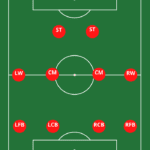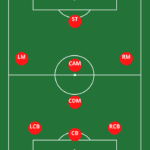Mastering the 4-3-3 Soccer Formation
Tactics And Strategies
- Last Updated -
Introduction to the 4-3-3 Soccer Formation
Explanation of the 4-3-3 formation
The 4-3-3 soccer formation is a commonly used tactical setup in modern football. It involves four defenders, three midfielders, and three forwards. The defenders typically consist of two center-backs and two full-backs, while the midfielders are often comprised of a central defensive midfielder and two central midfielders. The forward line typically consists of a center forward and two wide attackers who play closer to the sidelines.
This formation is popular because it allows for a balance between attacking and defensive play. The three midfielders provide a strong link between the defense and attack, while the three forwards can create and score goals. The full-backs are also free to get forward and support the attack when needed. Overall, the 4-3-3 formation is a versatile and effective system used by many successful football teams around the world.
Importance of understanding the 4-3-3 Soccer formation
Understanding the 4-3-3 soccer formation is crucial for players, coaches, and fans alike. It is a widely used and popular formation in modern football. The formation provides a balanced approach to attacking and defending with four defenders, three midfielders, and three forwards. The flexibility of the formation allows for tactical variations and adaptations during the game.
It requires players to have strong positional awareness and the ability to transition between attack and defense quickly. By understanding the 4-3-3 formation, teams can effectively utilize their strengths and exploit the weaknesses of their opponents. It also allows for better analysis and appreciation of the game for fans.
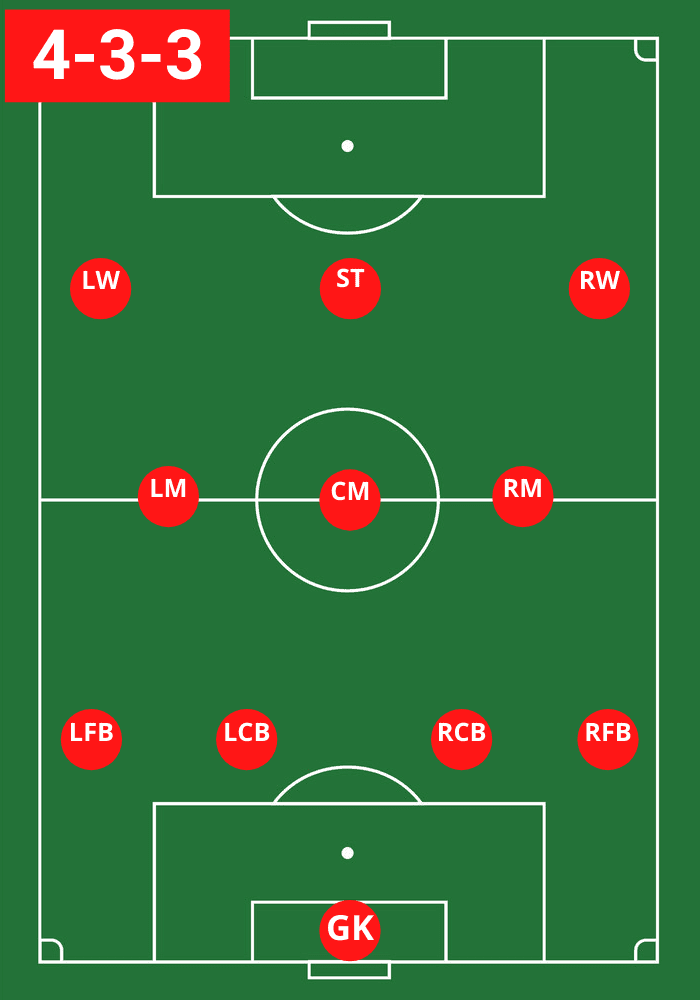
A brief history of the formation's evolution
The 4-3-3 formation in soccer has evolved and has been used by many successful teams. It first became popular in the 1960s with the Brazilian national team, who used it to win the 1970 World Cup. The formation is characterized by four defenders, three midfielders, and three forwards, and is known for its attacking style of play.
The 4-3-3 formation has since been adopted by many clubs and national teams around the world, including Barcelona, Real Madrid, and the Netherlands. Today, it remains a popular formation in modern soccer and is used by many top teams to great effect.

Benefits of the 4-3-3 Soccer Formation
Increased attacking potential
This formation places three forwards up front, with one central striker flanked by two wingers. This gives the team a potent attacking force that can stretch the opposition’s defense and create scoring opportunities.
The wingers can use their speed and skill to beat defenders and deliver crosses into the box, while the central striker can use his physicality and finishing ability to score goals.
In addition, the midfield trio behind the forwards can provide support and creativity, creating even more opportunities for the attacking players. The midfielders can use their passing and dribbling skills to create space for the forwards and deliver accurate through balls or crosses.
The 4-3-3 formation also allows teams to press higher up the field, putting pressure on the opposition’s defense and potentially winning the ball in dangerous areas. This can lead to quick counter-attacks and goal-scoring opportunities.
Overall, the 4-3-3 formation’s increased attacking potential makes it a popular choice for teams looking to play an exciting, attacking style of football.
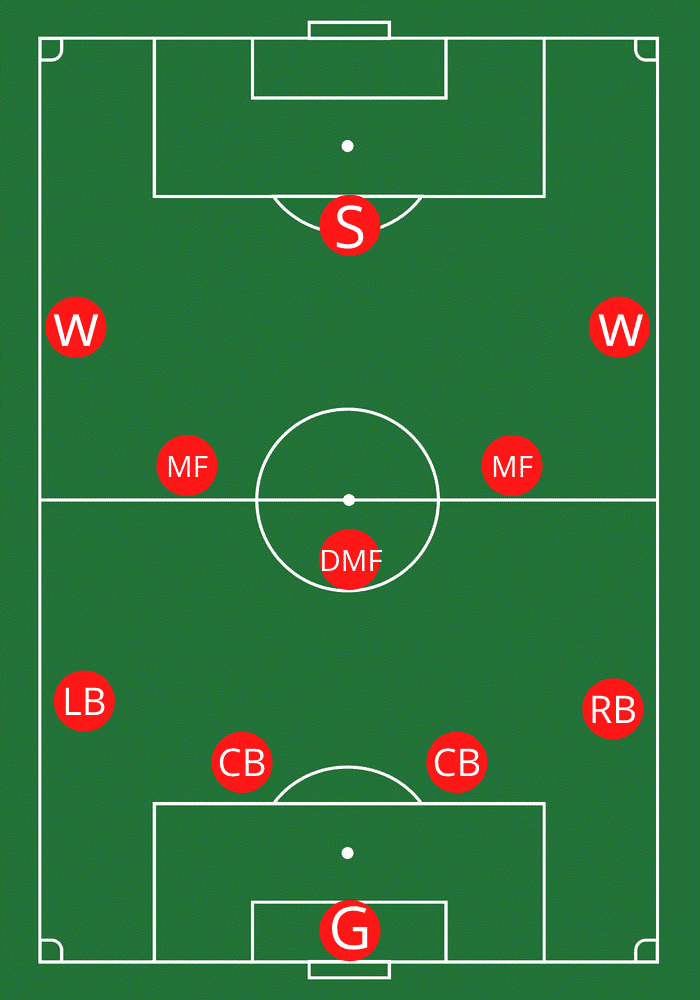
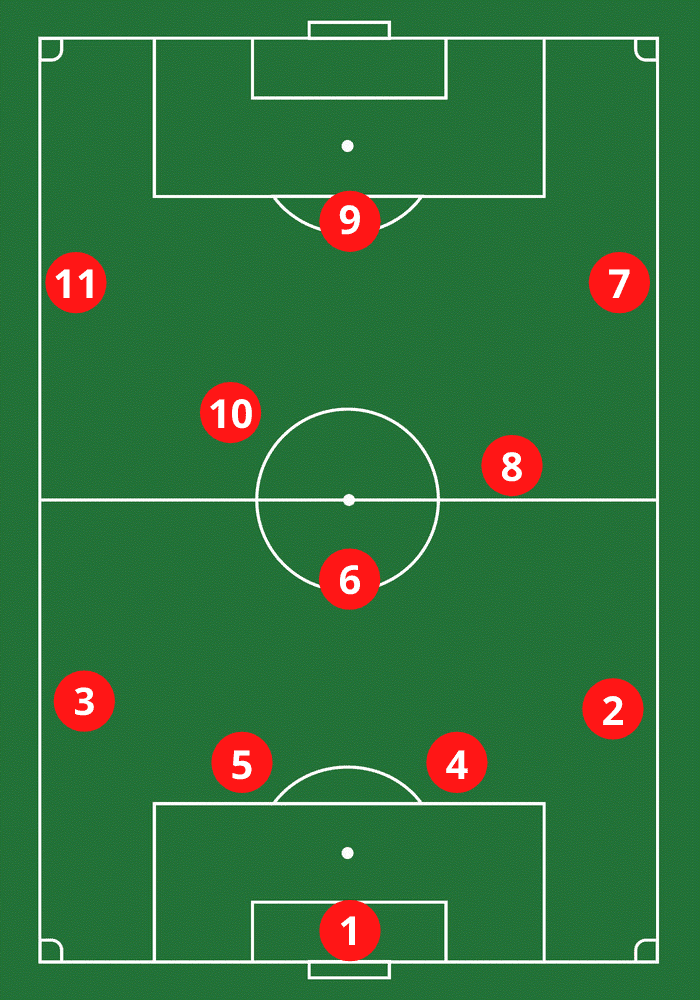

Improved defensive balance
The four defenders are usually two center-backs and two fullbacks. They provide a solid defensive foundation, with the two center backs providing cover for each other and the fullbacks helping to defend the flanks.
The three midfielders provide a good balance between attack and defense. The central midfielder is responsible for controlling the midfield and distributing the ball, while the two other midfielders have more defensive duties, such as pressing the opponent and breaking up their attacks.

The three forwards are usually a central striker and two wingers. The central striker is responsible for scoring goals, while the wingers provide width and create opportunities for the central striker to score.
The 4-3-3 formation allows the team to defend effectively while maintaining a strong attacking threat. The midfielders are well-positioned to track back and defend, while the forwards can quickly transition to attacking play when the team gains possession of the ball.
Overall, the 4-3-3 formation provides a good balance between defense and attack, allowing the team to play with confidence and control. The improved defensive balance is one of the many benefits of this popular formation.
Flexibility and adaptability
The 4-3-3 formation consists of four defenders, three midfielders, and three forwards. This setup allows for a balanced approach to the game, as it can be used to control possession and play defensively, while also providing a potent attacking threat.
The formation can be easily adapted to suit different styles of play and can be used to counter the strengths of the opposition. For example, if the opposition has a strong midfield, the 4-3-3 can be modified to include an additional defensive midfielder to provide extra cover.

Alternatively, if the opposition is weak in defense, the formation can be modified to include an extra striker to exploit this weakness.
The 4-3-3 formation is also flexible in terms of the players that can be deployed in each position. For example, the central midfielder can be a defensive or attacking player, depending on the team’s needs, and the wide forwards can also play as wingers or as inside forwards.
Overall, the 4-3-3 formation’s flexibility and adaptability make it an effective and popular choice for coaches and teams alike.
Success stories of teams using the 4-3-3 Soccer Formation
The 4-3-3 formation is a popular tactical setup in football that has been used by many successful teams around the world. One of the key benefits of this formation is its ability to create a balanced midfield that can control the game’s pace and direction.
With four defenders, three midfielders, and three forwards, the formation creates a solid foundation at the back, a strong midfield presence, and potent attacking options upfront. The midfield trio is especially crucial as it allows for a balanced distribution of playmaking, ball-winning, and defensive responsibilities.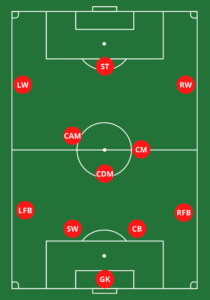
Several teams have used the 4-3-3 formation to great effect in recent years, including FC Barcelona, Liverpool FC, and the Dutch national team. FC Barcelona under Pep Guardiola was perhaps the most successful example of this formation, winning numerous titles including the UEFA Champions League in 2009 and 2011.
Liverpool FC, under manager Jurgen Klopp, has also used the 4-3-3 formation to great effect, winning the UEFA Champions League in 2019 and the English Premier League in 2020. The Dutch national team, under manager Ronald Koeman, also used the formation to reach the final of the UEFA Nations League in 2019.
Overall, the 4-3-3 formation’s ability to create a balanced midfield and potent attacking options makes it a popular and successful tactical setup for many teams.
Key Components of the 4-3-3 Formation
The role of the goalkeeper
In the 4-3-3 formation, the goalkeeper plays a critical role as the last line of defense for the team. Their primary objective is to prevent the opposing team from scoring goals by blocking shots, catching crosses, and making crucial saves. Goalkeepers also act as the team’s first line of attack, as they are responsible for distributing the ball to their teammates to start a counter-attack.
A good goalkeeper in a 4-3-3 formation needs to be quick, agile, and have excellent communication skills to coordinate with their defenders. Their ability to read the game, anticipate opposition movements, and communicate effectively is vital to the team’s success.

Defenders and their responsibilities
In the 4-3-3 formation, defenders play a crucial role in maintaining the team’s defensive shape and protecting their goal. The three defenders usually consist of two center-backs and a full-back. The center backs are responsible for covering the central areas of the pitch and marking the opposing team’s center forwards. They need to have strong tackling skills and aerial ability to win the ball in the air.
The full-backs play on the flanks and are responsible for both defending and supporting the team’s attacking efforts. They need to have good speed and stamina to cover the wide areas of the pitch and provide crosses or overlapping runs in the final third.
In addition to their responsibilities, defenders in the 4-3-3 formation need to work together to maintain their defensive shape and cover for each other when necessary. They must communicate effectively and be aware of the movement of the opposing team’s attackers. Overall, defenders are crucial in this formation, and their ability to work as a unit is essential to the team’s success.

Midfielders and their roles
The key component of this formation is the midfielders. They play a crucial role in connecting the defense with the attack and controlling the pace of the game.
In the 4-3-3 formation, there are typically three midfielders: a holding midfielder, a box-to-box midfielder, and an attacking midfielder. The holding midfielder is responsible for protecting the defense and breaking up opposition attacks.
The box-to-box midfielder covers the entire length of the field and plays a dual role of defense and attack. The attacking midfielder is the creative force in the team, responsible for providing the final pass and scoring goals.
Midfielders are also important in maintaining possession of the ball and playing quick, one-touch passes to keep the opposition on the back foot. They need to be versatile, possess excellent technical skills, and have good awareness of the game.
In summary, the midfielders are the engine room of the team in the 4-3-3 formation, and their ability to control the game is vital to the team’s success.
Forwards and their duties
In the 4-3-3 formation, there are typically three forwards, consisting of a center forward and two wingers. The center forward, also known as the striker, is responsible for leading the attack and playing the most advanced position.
Their main duty is to score goals, but they are also expected to hold up the ball, create space for their teammates, and provide an outlet for the midfielders.
The two wingers, on the other hand, are responsible for stretching the opposition’s defense and creating chances for themselves and their teammates.
They play a wide position and use their pace and dribbling ability to take on defenders and deliver crosses into the box for the center forward or other players to finish. They are also expected to track back and help the team defend when necessary.
Overall, the forwards in a 4-3-3 formation are crucial in providing the attacking threat that can make the difference in a soccer match.

Mastering the 4-3-3 Soccer Formation: Training and Strategies
Importance of practicing the formation
Mastering the 4-3-3 formation can be a valuable asset for any soccer team, and it’s crucial to practice the formation regularly to improve execution and effectiveness on the field. The 4-3-3 formation offers a balanced approach to the game, with three forwards providing an offensive threat, three midfielders offering cover, and fullbacks that can push forward or drop back to defend against counterattacks [2].
However, it’s important to note that this formation can leave the team vulnerable to counter-attacking play when the full-backs push high up to join the attack [1]. Therefore, it’s essential to have well-trained and disciplined full-backs to execute this formation effectively.
To master the 4-3-3 formation, players need to practice various aspects such as attacking, defending, and transition play. The formation requires constant movement and coordination between players to exploit the opposition’s weaknesses and create scoring opportunities [4].
Regular training sessions focusing on positional play, communication, and understanding each other’s roles can help players master the 4-3-3 formation and perform at their best on the field.
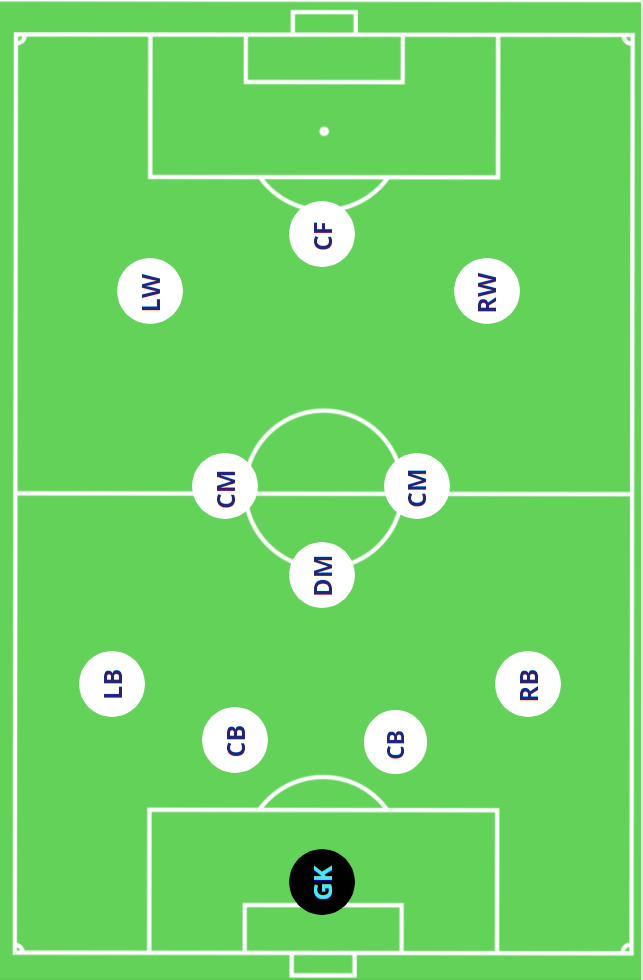
Recommended training drills for each position
The defensive line
of the 4-3-3 formation consists of two center-backs, a left-back, and a right-back [3]. For these players, training drills should focus on their ability to pressure the ball, cover for each other, and limit the opposition’s goal-scoring chances [4].
The midfield line
consists of three central midfielders, one defensive midfielder, and a left and right center midfielder [3]. The defensive midfielder, or anchor man, sits in front of the back four and protects them from counterattacks [2]. Training drills for these players should focus on their ability to control the midfield, create scoring opportunities, and defend against counterattacks.
The forward line
of the 4-3-3 formation consists of three strikers [2]. These players should focus on their ability to create scoring opportunities, make runs into the box, and finish with precision. Mastering the 4-3-3 formation requires each player to understand their role and execute specific training drills to improve their skills and coordination with the team.
Tactical strategies to maximize the formation's potential
To maximize its potential, a team must have a clear understanding of the roles and responsibilities of each position on the field. The formation is made up of three lines of players, with the defenders comprising the defensive line and the midfielders and attackers making up the two remaining lines [2].
One strategy to maximize the formation’s potential is to focus on creating width in an attack by using the wingers to stretch the opposition’s defense and create space for the central striker [1]. Another strategy is to use the midfielders to control the tempo of the game and provide a link between the defense and attack [3].
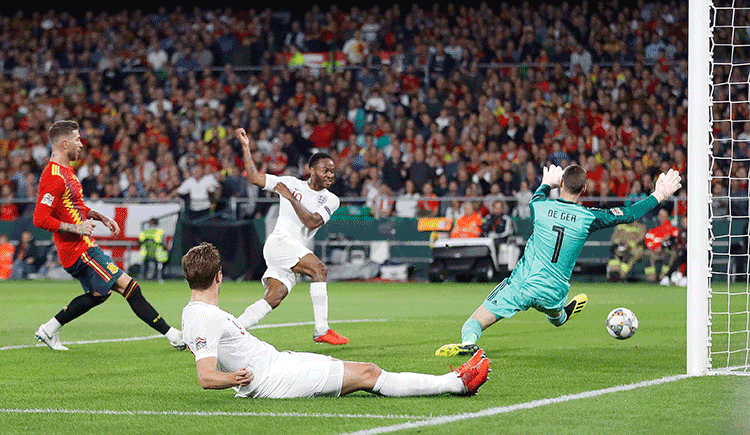
Defensively, the formation can be used to press high up the field and disrupt the opposition’s build-up play [5]. It is also important to have good communication and coordination between the players, especially the midfielders and defenders, to ensure the team maintains its shape and structure on the field [6].
Overall, mastering the 4-3-3 formation requires a combination of tactical awareness, technical ability, and teamwork. By utilizing strategies such as creating width in attack, controlling the midfield, and pressing high up the field, teams can maximize the formation’s potential and achieve success on the pitch.
Analyzing opponents to adapt the formation accordingly
This formation offers great coverage in both defense and attack, with three central midfielders and wingers on either side supporting two strikers up front.
To adapt the formation to opponents, coaches can analyze their play style, strengths, and weaknesses. For example, Barcelona’s use of the 4-3-3 formation with one holding midfielder has been successful due to its efficiency and adaptability.
One approach to analyzing opponents is to focus on their positioning and movement when they have possession of the ball, as this can help determine how to set up defensively and offensively [6].
Coaches can also consider the opposing team’s formation and make adjustments accordingly, such as adding or removing a midfielder or defender. By mastering the 4-3-3 formation and adapting it to opponents, coaches can create a versatile and effective strategy for their team.
Common Mistakes to Avoid in the 4-3-3 formation
Overcommitting to attack
The 4-3-3 soccer formation is a popular strategy that emphasizes attacking play, but overcommitting to attack can lead to common mistakes that can cost the team.
One common mistake to avoid is drifting too far up the field and leaving space behind the attacking players. This makes it easier for the opposing team to counterattack and increases the risk of conceding goals.
Another mistake is not having a proper balance between attack and defense. The 4-3-3 formation requires a balance between the three lines of players: the back four, the central midfielders, and the forward players. Overcommitting to attack can leave the defense vulnerable and increase the risk of conceding goals.
Therefore, it is important for teams playing with the 4-3-3 formation to maintain a proper balance between attack and defense and to avoid over-committing to attack, which can lead to common mistakes that cost the team.
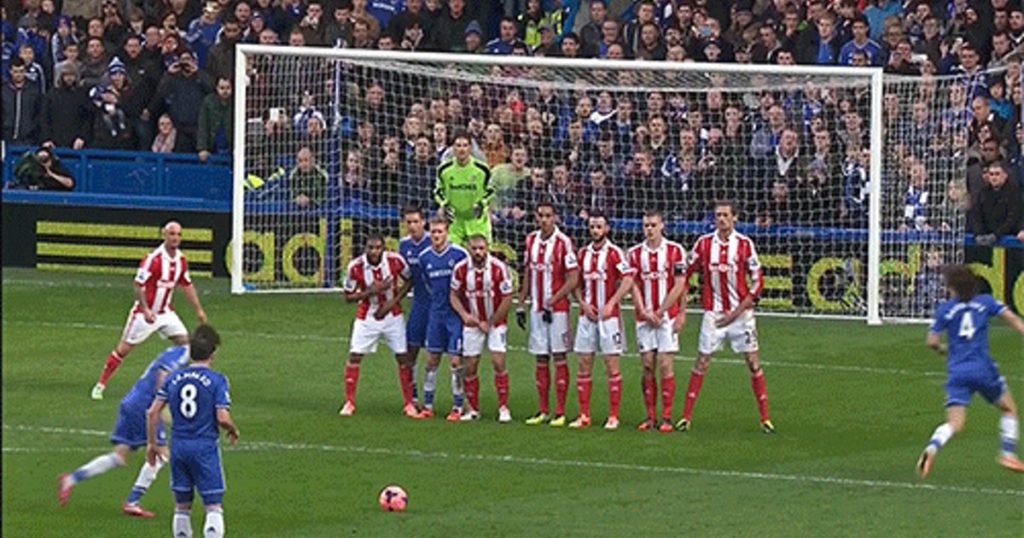
Neglecting defensive duties
A common mistake to avoid when playing with the 4-3-3 soccer formation is neglecting defensive duties, which can lead to conceding goals [1]. While the formation is designed to be offensive, it is important to maintain a balance between attacking and defending.
The attacking players must not drift too far up the field and leave space behind them, making it easier for opponents to counterattack and score goals [1]. The center backs play a critical role in the formation by preventing opposition strikers from scoring and anticipating the next move of the game [2].
Defensive strategies can also be implemented with the 4-3-3 formation, such as compacting the field and creating a strong wall of defenders to make it difficult for the opposing team to penetrate [5].
It is essential to train the team with the correct drills that emphasize quick passing and linking the entire team to exert dominance and counter high pressure [4]. Overall, while the 4-3-3 formation is an aggressive and effective strategy, it is important to avoid neglecting defensive duties to maintain a balanced approach on the field.

Poor communication and coordination
When playing with the 4-3-3 soccer formation, it is crucial to avoid poor communication and coordination among the players. [1] This formation involves three lines of players, and each line must work together cohesively. The defenders need to communicate well to prevent the opposing team from penetrating their defensive line.
The midfielders need to coordinate effectively to link the defense and attack, creating scoring opportunities. Finally, the attacking players must work together to create space and opportunities to score goals.
Players in the 4-3-3 formation should also avoid drifting too far up the field and leaving space behind them, as this increases the risk of conceding goals. [1] It is also essential to practice the correct drills, which help players exert dominance, counter high pressure, and provide passing options. [3]
To avoid communication and coordination issues in the 4-3-3 formation, coaches should emphasize clear communication and ensure players understand their roles and responsibilities.
Regular training sessions focused on teamwork and positioning will help players develop the necessary skills to play effectively in this formation. Overall, strong communication and coordination among players are vital to the success of the 4-3-3 soccer formation.
Failing to adapt to opponents' tactics
One common mistake to avoid with the 4-3-3 soccer formation is failing to adapt to opponents’ tactics. While the 4-3-3 formation can be effective in providing a lot of passing options and linking the entire team [1],
attacking players must be mindful of not drifting too far up the field and leaving space behind them, which can make it easier for opponents to counterattack and score goals [3]. Additionally, the main role of center-backs in any soccer team, including the 4-3-3 formation, is to prevent the opposition from scoring and anticipating their moves [2].
To avoid this common mistake, coaches and players should be aware of the opponents’ tactics and adjust their strategy accordingly.
This may involve playing a more defensive style to counteract an aggressive opponent or utilizing more pressing and attacking tactics against a weaker opponent. In short, being flexible and adaptable is crucial for success with the 4-3-3 soccer formation.
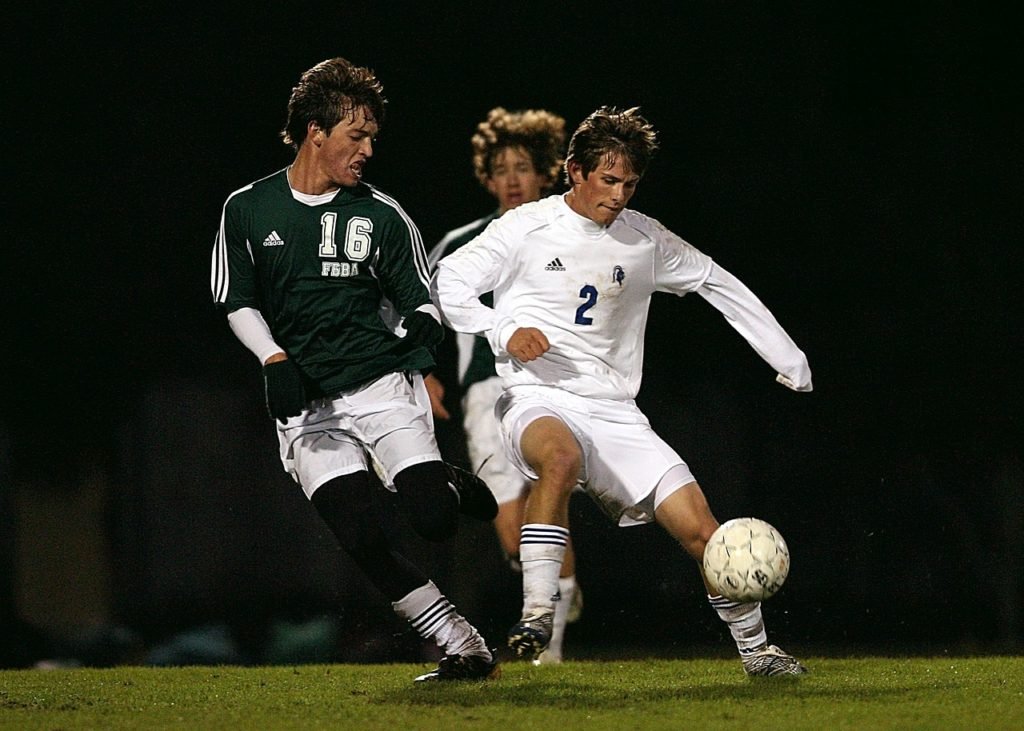
Here Are Some Teams That Have Mastered the 4-3-3 Soccer Formation
Four teams that have particularly mastered this formation are Barcelona FC under Pep Guardiola, Liverpool FC under Jurgen Klopp, the Dutch National Team under Rinus Michels, and Real Madrid under Carlo Ancelotti.
Barcelona FC under Pep Guardiola was arguably the most successful team to utilize the 4-3-3 formation. Guardiola’s version of the formation was characterized by its fluidity and high pressing. With Lionel Messi leading the front line, Barcelona FC won numerous titles, including three La Liga titles, two Champions League titles, and two FIFA Club World Cups [[1]].
Under Jurgen Klopp, Liverpool FC has also mastered the 4-3-3 formation. Klopp’s Liverpool is known for its high intensity and pressing style, and the 4-3-3 formation allows them to dominate the midfield and control the game. In their 2019-2020 season, Liverpool won the Premier League title, the UEFA Champions League, and the FIFA Club World Cup, all while playing a 4-3-3 formation [[2]].
The Dutch National Team under Rinus Michels is credited with creating the Total Football style of play, which was heavily based on the 4-3-3 formation. The team achieved great success in the 1970s, winning the 1974 World Cup Final and reaching the final again in 1978. The 4-3-3 formation allowed for fluid movement between players and for all players to contribute to both the defense and attack [[4]].
Lastly, Real Madrid under Carlo Ancelotti also found success with the 4-3-3 formation. With Cristiano Ronaldo as the central striker, Real Madrid won the UEFA Champions League and the Copa del Rey in the 2013-2014 season. The formation allowed for a balanced attack and for Ronaldo to thrive as the central attacking player [[6]].
In Conclusion
The 4-3-3 soccer formation is a popular strategy that involves 4 defenders, 3 midfielders, and 3 forwards. Understanding and mastering this formation can greatly benefit players and coaches alike. In this article, we will recap the benefits and components of the 4-3-3 formation, discuss the importance of mastering it, and provide final thoughts and recommendations for coaches and players.
Firstly, the 4-3-3 formation offers several benefits. It allows for a strong attacking presence, with three forwards that can apply pressure to the opposing team’s defense. It also provides a solid midfield presence, with three players who can distribute the ball and control the pace of the game. The four defenders provide a strong defensive structure, making it difficult for the opposing team to score.
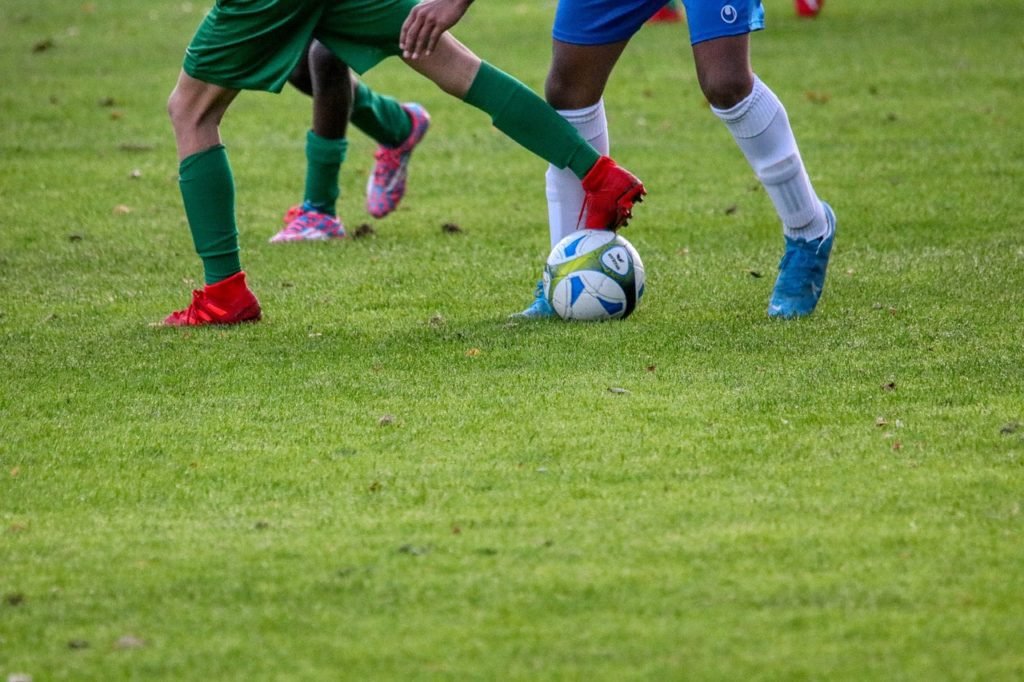
To master the 4-3-3 formation, players and coaches must understand its components. The formation requires players to have a strong understanding of their roles and responsibilities on the field.
For example, the forwards must have strong attacking skills and be able to work together to create scoring opportunities. The midfielders must have good passing skills and be able to both attack and defend. The defenders must be able to work together to protect their goal and prevent the opposing team from scoring.
It is important for players and coaches to understand and master the 4-3-3 formation because it can give teams a competitive edge on the field. By using this formation, teams can create a strong and cohesive game plan that maximizes their strengths and minimizes their weaknesses.
FAQs for 4-3-3 Soccer Formation
What is the 4-3-3 soccer formation?
- The 4-3-3 formation is a tactical setup in soccer involving four defenders, three midfielders, and three forwards. It balances attack and defense, with a strong link between these lines.
Why is understanding the 4-3-3 formation important?
- Understanding this formation is crucial for players, coaches, and fans, as it is popular in modern football and allows for tactical flexibility and quick transitions between attack and defense.
How did the 4-3-3 formation evolve?
- Originating in the 1960s with the Brazilian national team, the 4-3-3 formation has evolved over time and is now used by top teams worldwide for its attacking style of play.
What are the benefits of the 4-3-3 formation?
- This formation offers increased attacking potential and improved defensive balance, providing a potent attacking force and solid defensive structure.
How does the 4-3-3 formation offer flexibility and adaptability?
- The formation can be adapted to different styles of play and to counter opponents’ strengths, with flexible player roles.
Which successful teams have used the 4-3-3 formation?
- Teams like FC Barcelona, Liverpool FC, and the Dutch national team have successfully used the 4-3-3 formation, achieving significant victories.
What are the key components of the 4-3-3 formation?
- Key components include the roles of the goalkeeper, defenders, midfielders, and forwards, each with specific responsibilities.
Why is practicing the 4-3-3 formation important?
- Regular practice is essential for mastering the formation, improving execution, and effectiveness on the field.
What are recommended training drills for the 4-3-3 formation?
- Specific drills are recommended for each line (defense, midfield, forward), focusing on their unique roles and responsibilities.
What tactical strategies maximize the potential of the 4-3-3 formation?
- Strategies include creating width in attack, controlling the midfield, and pressing high up the field.
How can teams adapt the 4-3-3 formation to opponents?
- Teams can analyze opponents’ play style and adjust the formation accordingly, adding or removing midfielders or defenders as needed.
What are common mistakes to avoid in the 4-3-3 formation?
- Teams should avoid overcommitting to attack, neglecting defensive duties, poor communication, and failing to adapt to opponents’ tactics.




